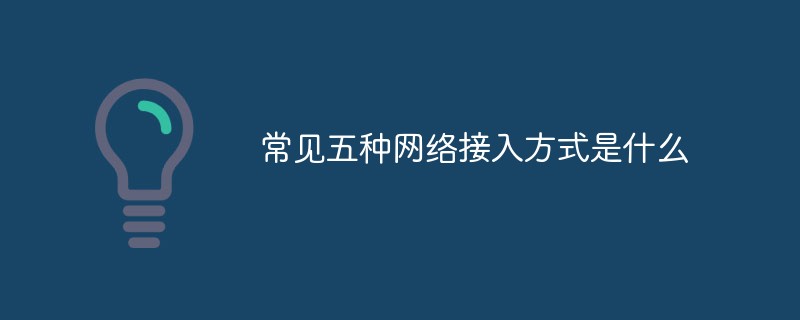
The five common network access methods are: 1. Dial-up Internet access; 2. ISDN Internet access method; 3. Broadband Internet access method; 4. Fiber optic broadband Internet access method; 5. Wireless Internet access method.

The operating environment of this tutorial: Windows 10 system, Dell G3 computer.
Let me introduce to you the five commonly used network access methods
1. Dial-up Internet access
Dial-up Internet access was when the Internet first appeared The most common way for ordinary people to connect to the Internet, this was the most widely used method of Internet access in the past. It connects computers to the Internet through modems and phone lines, and then further accesses network resources. The advantages of dial-up Internet access are: it can be easily installed and configured, and the one-time investment cost is low. Users only need to obtain an Internet access account from the ISP (network operator), and then connect the necessary hardware settings to access the Internet. But using dial-up Internet access is slow and the access quality is poor, and if you are surfing the Internet, you cannot receive calls at the same time. If you don’t spend a long time surfing the Internet, it is more suitable to use this method of surfing the Internet.
2. ISDN Internet access method
ISDN is the abbreviation of Integrated Service Digital Network. It is an international standard for digital telephone networks, that is, narrowband integrated services digital network, commonly known as " "One Line", which also uses existing phone lines to access Internet. ISDN is generally used in network environments with frequent uploads. The advantages and disadvantages of this method of accessing the Internet are
Advantages:
Comprehensive same letter service: use a The subscriber line can realize various services such as telephone, fax, video text, and video phone.
High quality of transmission: Due to the use of end-to-end digital connections, terminal to terminal is fully digitalized, and the quality of transmission is significantly improved.
Flexible and convenient to use: only one network access interface is needed, and a unified number can be used to obtain the various services required from the network, and multiple services of different types can be connected. terminal.
Disadvantages:
The speed is not fast enough compared to access methods such as ADSL and LAN.
The cost of being online for a long time will be very high.
Equipment costs are not cheap.
3. Broadband Internet access method
Broadband Internet access ADSL (Asymmetric Digital Subscriber Line), which is an asymmetric digital subscriber line. ADSL technology uses frequency division technology to separate low-frequency signals and high-frequency signals transmitted by ordinary telephone lines. It is a technology for high-speed data transmission on ordinary telephone lines. It uses frequencies that have never been used in telephone lines. Therefore, the 56kbPS speed limit of the modem can be exceeded.
The characteristics of ADSL technology are as follows:
(1) The transmission rate can reach up to 640Kpbs in the uplink and up to 8Mbps in the downlink, which is much higher than dial-up Internet access.
(2) Only network usage fees are charged, and low rates of Internet phone calls are not charged.
(3) It can coexist with an ordinary telephone line on a telephone line, and can receive and make calls on an ordinary telephone line while performing ADSL transmission without affecting each other.
The disadvantage of ADSL broadband Internet access is that it cannot transmit analog signals.
We can use the following table to compare the three link methods introduced above
4. Optical fiber broadband Internet access method
Optical fiber broadband is to convert the data to be transmitted from electrical signals into optical signals for communication. "Optical cats" are installed at both ends of the optical fiber for signal conversion. This method of accessing the Internet can enable download speeds up to 6Mbps and upload speeds up to 640kbps. Optical fiber is the most ideal among various transmission media in broadband networks. It is characterized by large transmission capacity, good transmission quality, low loss, and long relay distance. The advantages of fiber optic Internet access are exclusive bandwidth, stable performance, low upgrade and transformation costs, no electromagnetic interference, low loss, strong security and confidentiality, and long transmission distance. The difference between fiber optic broadband and ADSL access methods is that ADSL is an electrical signal propagation, while fiber optic broadband is an optical signal propagation.
5. Wireless Internet access method
Wireless Internet access refers to the Internet login method using wireless connection, which uses radio waves as the medium for data transmission. That is to say, there is no need to use phone lines or network lines, but to connect to the Internet through communication signals. As long as the user's location is within the radio wave coverage of the wireless access point, coupled with a compatible wireless network card, the user can easily access the Internet. Nowadays, wireless Internet access has been widely used in business districts, universities, airports, and other types of public areas, and its network signal coverage area is further expanding.
The advantages of wireless Internet access are:
Not limited by location and time;
The software article is fast;
You can also send and receive text messages using a wireless Internet card;
One disadvantage of wireless Internet access is that the cost is relatively high.
For more related knowledge, please visit theFAQcolumn!
The above is the detailed content of What are the five common network access methods?. For more information, please follow other related articles on the PHP Chinese website!